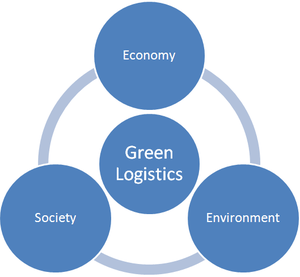Green logistics
Green logistics describes all attempts to measure and minimize the ecological impact of logistics activities. This includes all activities of the forward and reverse flows of products, information and services between the point of origin and the point of consumption. It is the aim to create a sustainable company value using a balance of economic and environmental efficiency. Green logistics has its origin in the mid 1980s and was a concept to characterize logistics systems and approaches that use advanced technology and equipment to minimize environmental damage during operations.[1]
Demand for action

Organizations have to face changes in the coming years.
In addition to increasing diversity and dynamics, environmental issues become more important. Social, political and economic demands for sustainable development force organizations to reduce the effect on the environment of their supply chains and to develop sustainable transport and supply chain strategies.[2]
There are strong interactions between logistics, environment and natural resources. In addition, the approach of logistics is interdisciplinary, holistic and cross-company[3] Realising environmental objectives can be done in synergy with other strategic and financial goals. This is the basis of the great potential of this new logistics problem and challenge.[4]
Ecological concern
The "ecological concern" in logistics determines how far the logistics or the supply chain of a company is faced with the issue of environmental protection and resource conservation. Basically, a supply chain is affected of various influencing factors in this context. The main influencing factors are the stakeholders of the organization and the rising costs of energy and commodity.[5]
Some of the key stakeholders in this context are:
- The state with growing international and national regulations
- Customers and consumer with increasing awareness and demand for ecofriendly products and (logistics) services
- Employees who want to work in an environmentally and socially responsible company
- Society with increasing claims for more corporate social responsibility (CSR)
- Companies themselves; dealing with their own motivation
There is also the pressure of lenders, investors, insurers and investors. Indications of this are new forms of investment in the capital market, such as the Dow Jones Sustainability Index, that tracks the stock performance of the world's leading companies in terms of economic, environmental and social criteria.[6]
The dimension of ecological concern of a company is the product of these complex and varying factors.
Approaches
Logistics has a whole range of measures to protect the environment and resources. Some are new, others long-known. These actions can be assigned to different levels – maturity, range, scope, capital expenditure and resource requirements.
Corresponding to the holistic approach of green logistics, logistics has five starting points to implement measures for environmental protection and resource conservation:
- customer, market and product
- structures and planning
- processes, control and measurement
- technologies and resources
- employees, suppliers and service providers
Examples:[7]
- More efficient packing
- Route optimization
- Load optimization
- Formation of corporate networks, which are connected by logistics service
- Optimizing physical logistics processes by providing a sophisticated IT support
The first four levels form a hierarchy and influence each other sequentially. Decisions on one level define the scope for further decisions on the following levels. Decisions at higher levels reduce the freedom for the following levels. Example: The determination of the packing mass of a product on the Level one defines the volume and weight of a product and therefore the maximum number of items per carrier (e.g., container). Thus, the decision made on level one influences the maximum capacity of a container. The effects on the environment, – measured as carbon-dioxide (CO
2) emissions per transported product – therefore, are strongly influenced by the decisions made on level one. Decisions made on levels two and three, such as route optimization, also affect carbon-dioxide emissions.[8]
See also
External links
- EcoTransIT - Calculation of energy consumption and emission data for freight transports
- GreenRouter - Calculation of energy consumption and emission data for freight transports
- Green Logistics - A research programme examining a range of ways of reducing environmental impact, many of which will also cut the cost of distribution. Funded by the Engineering and Physical Science Research Council (EPSRC) and supported by the Department for Transport and Transport for London
References
- Thiell, M., Zuluaga, J., Montanez, J., van Hoof, B.: Green Logistics – Global Practices and their Implementation in Emerging Markets, p. 2, Colombia 2011.
- . Retrieved 27 November 2012.
- Hoessle, Ulrike: Sustainable Logistics. Best Lessons from the Global Compact (=WWS Series 2). Seattle 2013. ISBN 978-0-9898270-1-0, http://www.wwsworldwide.com.
- Archived 6 February 2013 at the Wayback Machine. Retrieved 27 November 2012.
- . Retrieved 27 November 2012.
- . Retrieved 27 November 2012.
- Johannes Kals: Betriebliches Energiemanagement – Eine Einführung, pp. 95–98, Kohlhammer Verlag, Stuttgart 2010, ISBN 978-3-17-021133-9.
- Straube, F., Cetinkaya, B: Umwelt und Logistik, pp. 62–81 in Straube, F.; Pfohl, H.-Chr.: Trends und Strategien in der Logistik – Globale Netzwerke im Wandel, Deutscher Verkehrs-Verlag, Bremen 2008, ISBN 978-3-87154-388-3.
DONATO. V. Logística Verde: uma abordagem Socioambiental. Rio de Janeiro: Editora Ciência Moderna. 2008. ISBN 978-85-739-3705-3.